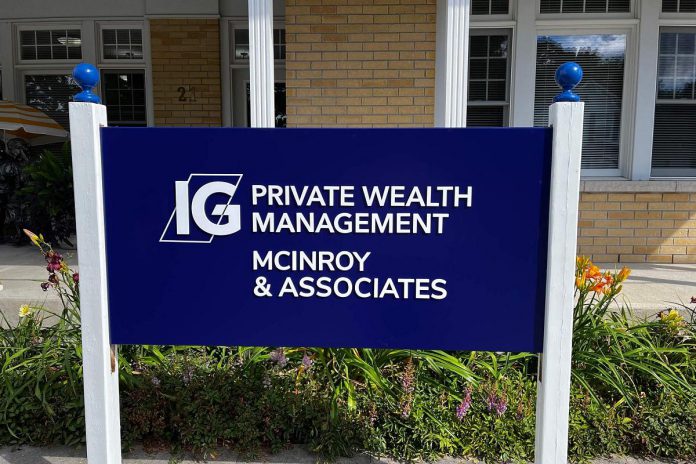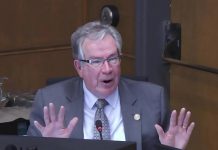
Each client who envisions what retirement will be like and comes through the door of Kawarthas-based McInroy and Associates Private Wealth Management is unique, arriving with varying assets and equally different expectations of what they hope retirement will look like.
But what they all have in common, according to financial consultant Adam McInroy CFP, CLU, is the need to have sustained income during retirement that’s going to keep up with the cost of living and to minimize the amount of tax they pay. They want financial security.
“Let me walk through a conversation we recently had with a married couple to illustrate to you what that looks like,” Adam says. “He is retired with a defined benefit pension plan. She is working, several years away from retirement, with $900,000 in registered assets between her group RRSP and her defined contribution pension plan.”
The couple’s shared ambition is simple: to enjoy a low-key but comfortable retirement lifestyle — a golden years’ existence that will allow them to enjoy the fruits of their retirement assets but still leave something for their children.
“It might be simple, but one of the first questions I asked them was ‘Where are you going to live?'” Adam recalls. “We all need a roof over our head.”
The couple told Adam they had already sold their primary residence and were residing on a lake in an old family cottage they had inherited.
At that point, Adam knew how the couple decides to handle the house sale proceeds would be a critical piece of their retirement plan puzzle, not just for today but also in the long term.
“If they went online and searched for the answer to that question, they probably read a dozen different options,” Adam says. “A common answer may be ‘Put the house sale proceeds in the group RRSP and lower your income tax bracket.’ That sounds great initially, but one of the bigger planning components we want to look at over the next 15 to 25 years is what taxable sources of income they’re going to have.”
“We know the husband has a defined benefit pension plan so hopefully, even though the wife is not retired yet, that’s pension income that could be at least shared for pension income splitting and tax credit purposes, helping minimize overall tax for the household each year.”
“The second thing we know is there’s $900,000 of taxable assets in the future for them to draw on, between the group RRSP and defined contribution pension plan, plus there’s going to be OAS and CPP income. Saving taxes today is great, but we need to ask the question: if the impact in retirement is that you’ll end up paying more taxes, is that actually beneficial?”

That’s when Adam broaches the subject of a Tax-Free Savings Account (TFSA), a piece of the financial planning puzzle the couple hadn’t considered.
They are not alone. According to a 2022 study commissioned by BMO, while two-thirds of Canadians have a TFSA, only half are aware that a TFSA can hold both cash and other investments, such as stocks, bonds, mutual funds, and GICs.
“A TFSA can provide a significant benefit for this family, allowing up to $88,000 to be deposited and invested for future retirement income needs,” Adam points out.
“For this couple, I would look at the TFSA as a vehicle to help them achieve the retirement they want. The word ‘savings’ is misleading. Most people think of it as just a savings account that generates simple interest. I refer to the TFSA as a tax-free investment account, meaning you can select how you want the money invested inside of this account.”
“For this couple, why would we want to take that generally tax-free lump sum from the house sale and put it into something that we’re going to pay taxes on down the road? With a TFSA, we can generate an investment return that’s going to work for them throughout retirement, which keeps pace or exceeds inflation, allowing them to maintain a lifestyle of comfort and dignity by creating a source of income that does not create a tax liability.”
Compare this option — a tax free pot of money — to an RRSP strategy that would generate a tax benefit today but result in a taxable income stream later on in retirement.
“That strategy just doesn’t make sense while they are both alive, With a married couple, one is generally going to pre-decease the other. For the surviving spouse, a TFSA provides the ability and the flexibility to draw income when it’s needed from non-taxable sources, which is beneficial when there are no long two tax returns to split income across. A TFSA provides an income source that can be drawn from but may help avoid moving the surviving spouse up into a higher tax bracket.”
Another consideration, notes Adam, is to account for the future cost of living.
“We’ve been telling people for years that two per cent inflation is beautiful but, over 20 or 25 years, inflation significantly impacts your purchasing power,” he says. “It’s not just about putting money in a TFSA and building a non-registered portfolio. How we build out an investment strategy to achieve the goal of keeping up with or surpassing inflation is critical.”

The defined contribution pension plan component deserves special attention, Adam says.
“Unlike a defined benefit pension plan, which can pay you a steady income for as long as you live and upon your passing goes to your spouse generally at 60 per cent, a defined contribution plan means you, as the owner, take on the investment risk and income strategy planning.”
“The nice thing is, when you retire, the defined contribution comes out and you get to manage it in the form of a LIRA (Locked-In Retirement Account). There’s pension legislation surrounding how you can take the money out and, after the age of 55, you can start taking a monthly or annual income out of that account. It’s important, though, that you understand some of the options you have when you first unlock a LIRA.”
“A LIRA account generally goes from a LIRA account to a LIF (Life Income Fund) account. A LIF account has a prescribed minimum income and maximum income that must be withdrawn. As you can imagine, that can be limiting in terms of income planning. Compare that to an RRIF (Registered Retirement Income Fund) account that has a minimum amount that is prescribed and has to come out every single year, but no maximum amount ”
“One of the strategies we generally want to employ is unlocking 50 per cent of the LIF account within the first 60 days that it’s open. Hypothetically, if we have $200,000 sitting in a LIF account when it’s set up, we can move $100,000 to an RSP/RRIF account. It’s all done without income tax issues, but what that gives the household is increased flexibility of income streams.”
“This couple may want to have a baseline income for a few years and then do a few big trips. There may be years when they may want to pull out extra income. This gives them the ability to create income flexibility through their retirement.”
“As Canadians, we have the fortunate benefit of having OAS and CPP systems in place. I call that a foundational income stream. Having a few other pots of money that can create income without 100 per cent taxation can be very beneficial. TFSAs and non-registered accounts/open accounts are other vehicles that allow for a diversified income stream heading into retirement.”
According to Adam, spreading out taxable income over multiple years — rather than having a lot of taxable income in one year and none in future years — is generally a better strategy for reducing overall tax liability.
“The immediate logic is ‘I want to drop my tax bracket now, so I’m going to take some of the proceeds from the sale of my principal residence and put it into my RRSP.’ The big question to ask is are you just reducing taxes today and are you going to end up paying more taxes down the road?”

Adam strongly encourages both individuals and couples who are approaching retirement to seek out the counsel of a CERTIFIED FINANCIAL PLANNER professional — “someone who does this day in and day out and knows what questions to ask” — as opposed to “trying to Google for answers. Google is great at giving you answers but, if you don’t know what questions to ask, you’re going to get answers that may not make sense for you.”
“Do you really want to spend your time and energy trying to figure out your different sources of income and how you can best build your income streams for the next 30 years? Or do you want to work with someone who has been doing that for 20 or 30 years, has a proven track record, and knows how the tax changes impact seniors’ retirement income streams and planning opportunities?”
“Our niche is servicing clients on the cusp of retirement and doing so in a manner that nets them a benefit in the reduction of taxes, coupled with an investment strategy designed to provide income for as long as they need that’s going to keep up with the cost of living.”
McInroy & Associates Private Wealth Management is located at 21 King Street West in Bobcaygeon. You can email Adam at adam.mcinroy@igpwm.ca or call 705-748-1950. For more information about McInroy & Associates Private Wealth Management, visit www.mcinroypwm.com.
Investors Group Financial Services Inc.
This is a general source of information only. It is not intended to provide personalized tax, legal, or investment advice, and is not intended as a solicitation to purchase securities. Adam McInroy is solely responsible for its content. For more information on this topic or any other financial matter, please contact an IG Wealth Management Consultant.
This is one of a series of branded editorials created in partnership with McInroy & Associates Private Wealth Management. If your business or organization is interested in a branded editorial, contact us.


























